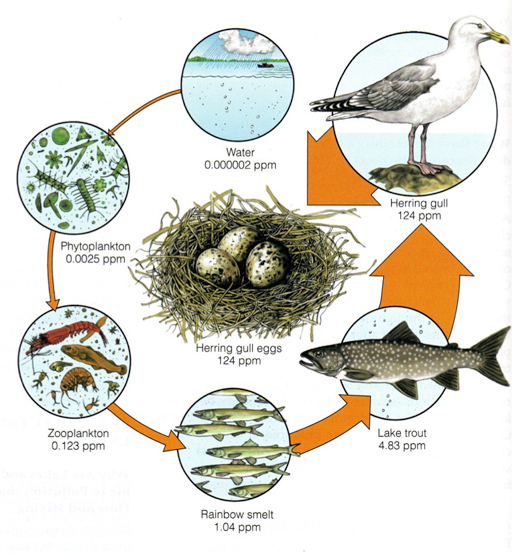8.1.3 Effects of persistent pollutants
Persistent pollutants, such as heavy metals and persistent organic pollutants (POPs), were mentioned in Study Session 7.
Why are persistent pollutants a major environmental problem?
Persistent pollutants are a major problem because they do not break down by natural degradation processes and therefore remain in the environment for a very long time.
These pollutants may be present at very low concentrations in water but, over time, they build up in the tissues of organisms by a process called bioaccumulation. These chemicals have no known biological function in animals and there is no process to expel them from the body. If the chemicals are ingested or otherwise absorbed from the environment, they remain in the body and gradually accumulate. This is a particular problem for fish and shellfish that feed by filtering plankton from very large volumes of water. If the plankton are contaminated, this will pass into the fish. The pollutants become more and more concentrated and can reach toxic levels.
Figure 8.4 shows how levels of heavy metals, in this case mercury, increase through a food chain. A food chain is the sequence of who eats whom, or what. In Figure 8.4 you can see that the concentration of mercury in water is very low, but increases in the bodies of phytoplankton (small aquatic plants), then in zooplankton (small aquatic animals) as they eat the phytoplankton, and then in the bodies of fish that eat the zooplankton and finally in fish-eating birds. The chemicals can also be passed on to eggs and damage reproduction of the birds. This gradual increase in concentrations through the levels of a food chain is a form of bioaccumulation called biomagnification.

The aquatic food chain extends to terrestrial (land-living) animals and humans. The amount of a pollutant such as mercury can reach a level dangerous enough to cause harm if consumed. Mekuyie (2014) analysed the levels of heavy metals in milk from cows that had drunk water from lagoons that contained wastewater from a textiles factory in Hawassa. The milk contained unsafe levels of heavy metals. The study concluded that this could have toxic effects on people who drank the milk, as well as decreasing livestock productivity and causing damage to the aquatic ecosystem.
Pollutants will continue to bioaccumulate in plants and animals as long as the pollution continues. The Hawassa example demonstrates that some pollutants do not go anywhere, but instead become a part of our life system in the environment.
8.1.2 Effects of excess nutrients on the environment
